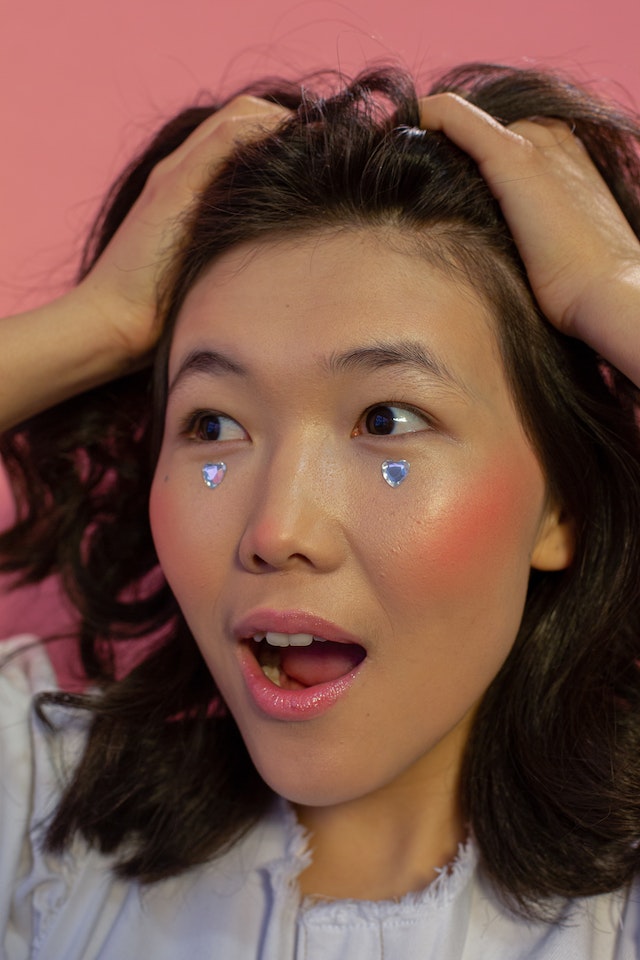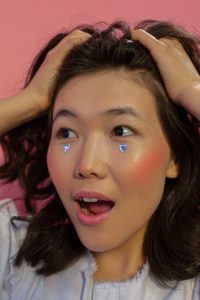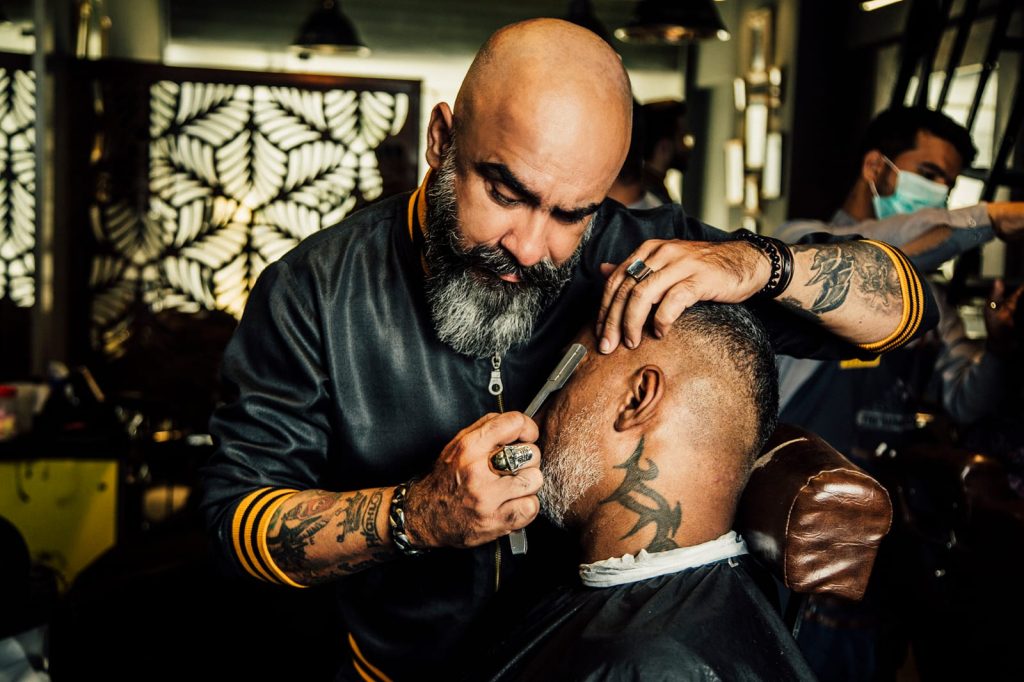Beauty Fitness
Conquering Perpetually Greasy Hair Troubles: Insider Tips from a Stylist

Introduction:
Perpetually greasy hair can be a frustrating and challenging issue to deal with. Many factors contribute to this problem, including overactive oil glands, poor hair care habits, and hormonal imbalances. Understanding the challenges associated with greasy hair is crucial in finding effective solutions.
One of the main challenges of having perpetually greasy hair is the constant need for washing. Grease buildup makes hair look dirty and unkempt, so frequent washing becomes necessary. However, excessive washing can strip the scalp of its natural oils, leading to even more oil production as a result.
Another challenge is finding suitable hair care products that balance oil production without drying out or weighing down the hair. It can be a trial-and-error process to find shampoos and conditioners that effectively cleanse and moisturize without leaving behind residue or adding excessive shine.

Photo by Monstera: https://www.pexels.com/photo/asian-female-with-rhinestones-in-shape-of-hearts-on-cheeks-6973945/
Styling also presents challenges for those with perpetually greasy hair
Grease tends to weigh down hairstyles and inhibit volume and hold. It becomes difficult to achieve desired looks that last throughout the day.
Social implications are also worth considering when dealing with perpetually greasy hair. People may make assumptions about personal hygiene based on appearance alone, leading to potential self-consciousness or embarrassment.
Addressing these challenges requires a multifaceted approach. Proper scalp hygiene plays a significant role in managing oily roots; avoiding harsh shampoos or hot water helps maintain balance without stripping essential oils entirely.
Choosing lightweight styling products formulated specifically for oily-prone locks allows individuals to achieve their desired styles while minimizing buildup or grease accumulation throughout the day.
Additionally, adopting lifestyle changes such as managing stress levels and maintaining a balanced diet can help regulate hormonal imbalances that contribute to excessive oil production.
While dealing with perpetually greasy hair poses numerous challenges, understanding them empowers individuals to take action towards healthier-looking locks. Through proper care routines tailored for oily-prone scalps and experimenting with different products suited for their specific needs, people can find effective solutions and regain confidence in their hair’s appearance.
Having constantly oily hair can be quite irritating. Excessive sebum production by the scalp leads to greasy hair, causing it to look oily and heavy. This condition can be influenced by a variety of factors, including hormonal imbalances, genetic predisposition, and inadequate hair care routines. Acknowledging the unique difficulties associated with constantly oily hair is the initial stage in discovering successful remedies.
Creating a personalized hair care routine for greasy hair can help manage excessive oil production and keep your hair looking fresh. Here are some tips to customize a routine that suits your needs:
1. Use a clarifying shampoo: Start your routine by using a clarifying shampoo once or twice a week. This will help remove build-up and excess oil from your scalp.
2. Avoid over-washing: While it may be tempting to wash greasy hair frequently, over-washing can strip away natural oils and actually increase oil production. Aim to wash your hair every other day or every two days.
3. Focus on the roots: When washing, pay extra attention to the roots of your hair where oil tends to accumulate the most. Gently massage the shampoo into your scalp to cleanse thoroughly.
4. Use a lightweight conditioner: To avoid adding unnecessary heaviness or additional oils to your hair, choose a lightweight conditioner specifically formulated for oily/greasy hair types. Apply it mainly on the ends of your hair, avoiding the roots.
5. Try dry shampoo: On non-wash days, opt for dry shampoo in between washes as it helps absorb excess oil at the roots and provides volume.
6. Limit heat styling: Excessive heat styling can stimulate oil production in the scalp, so try to limit the use of hot tools like curling irons or straighteners.
7.Train Your Hair: If you find that you need frequent daily washing due very oily locks then consider training you’re here by gapping out one day between shampoos gradually working up two skipping three days etc this is not doable right up front but with time you’ll see results
8.Style wisely- Choose hairstyles that don’t touch too much with her face or use heavy products like gels mousses pomades etc
Remember that everyone’s hair is unique, so feel free to adjust this routine based on what works best for you. It may take some trial and error to find the perfect products and techniques for managing your greasy hair, but with consistency, you can achieve healthier-looking locks.
It is essential to develop a personalized hair care regimen that specifically addresses your oily hair in order to effectively manage and regulate the excess oil. Consider the following steps:
Select a clarifying shampoo that is specifically formulated for oily hair. Check for components like tea tree oil, salicylic acid, or citrus extracts in the product. They can effectively clean and restore the scalp’s natural oil balance without removing necessary oils.
Emphasize scalp cleansing: Direct the shampoo primarily to your scalp rather than focusing on the rest of your hair. Carefully rub the shampoo into your scalp to eliminate any excessive oil, dirt, or buildup from hair products.
Make sure to rinse your hair completely to eliminate any leftover shampoo and conditioner. Product residue can make your hair heavy and contribute to oiliness.
Avoid heavy conditioners. Use a small amount of conditioner and target the tips of your hair to avoid making your scalp oily. Seek out weightless conditioners that are free of oil to avoid weighing down your hair.
Coping with constantly oily hair necessitates specialized advice and techniques.
1. Wash your face twice a day using a gentle cleanser that is specifically formulated for oily or greasy skin. Avoid using harsh soaps or scrubbing too vigorously, as this can strip the skin of its natural oils and cause it to produce even more oil.
2. Use oil-free and non-comedogenic skincare products, such as moisturizers, sunscreens, and makeup. Look for labels that say “oil-free” or “non-comedogenic” to ensure that they won’t clog your pores and contribute to greasiness.
3. Exfoliate your skin regularly to remove dead skin cells and unclog pores. Opt for gentle exfoliants like salicylic acid or glycolic acid, which can help regulate oil production.
4. Use blotting papers throughout the day to absorb excess oil from your face without disturbing your makeup. Simply press the blotting paper onto oily areas of the skin, such as the forehead, nose, and chin.
5. Avoid touching your face with dirty hands as this can transfer bacteria and oils onto the skin, leading to breakouts and increased greasiness.
6. Consider using a clay mask once or twice a week to absorb excess oil from the skin’s surface and tighten pores.
7. Be mindful of the types of foods you consume as some studies suggest that certain foods high in sugar or unhealthy fats can contribute to oily skin. Opt for a balanced diet consisting of fruits, vegetables, lean proteins, whole grains, and healthy fats like omega-3 fatty acids found in fish.
8.Try not stress too much since stress can increase oil production on your face causing it seem more greasy
9.Make sure cover any open wounds by either keeping them bandaged up properly cleaned/sterilized so u don’t have any extra oils/bacteria entering into an open wound
Wash your hair appropriately
Maintain regular hair washing routines, but be cautious not to overdo it, as excessive washing can stimulate the scalp to produce excess oil. Discover a routine that suits your needs, usually alternating days or when necessary.
Use water that is comfortably warm: Using hot water can cause your sebaceous glands to produce more oil. Choose lukewarm water when cleansing your hair to keep your scalp balanced.
Don’t skip conditioner entirely. Avoiding conditioner completely can result in dry and imbalanced hair and scalp. Apply a gentle, weightless conditioner to the ends of your hair to retain moisture without weighing down the roots.
Consider trying natural treatments to manage oiliness. Using a diluted solution of apple cider vinegar to rinse your hair can help eliminate residue and bring back harmony to the scalp.
Tips to Achieve Beautiful, Oil-Free Hair
You can still create stunning hairstyles even if you have constantly oily hair. Consider the following styling hacks:
Consider using dry shampoo to combat oily hair. Massage the product into the roots, paying extra attention to oily sections, in order to soak up any extra oil and create more body.
Try different hairstyles like updos, braids, and textured looks to hide oily hair. These hairstyles can conceal any greasy hair and give your locks a clean and trendy appearance.
Minimize the use of heat styling tools to prevent excess oiliness from being more apparent. To decrease the accumulation of oil, try using heatless techniques for styling instead of relying on hot tools.
Ensure you regularly clean your styling tools to prevent the transfer of oil and product buildup onto your hair. Regularly cleaning your brushes, combs, and hair accessories is important for keeping a clean and oil-free atmosphere.
By incorporating these professional tips and techniques, you can overcome your persistent issue of oily hair. Say farewell to oily hair and welcome vibrant, clean, and revitalized locks. Adopt these techniques and regain your self-assurance with beautiful, oil-free hair.
Beauty Fitness
Bad Bunny Merch and Bad Bunny Shirt: A Complete Guide for Fans

Introduction
Bad Bunny has become one of the most influential artists in the world, known not only for his groundbreaking music but also for his bold fashion sense. His unique style has inspired a massive wave of merchandise that fans love to collect and wear with pride. Among all the popular items, Bad Bunny merch and the exclusive Bad Bunny shirt stand out as fan favorites. In this detailed guide, we will explore the meaning, styles, popularity, and cultural impact of Bad Bunny merch.
Who Is Bad Bunny?
Before diving into his merchandise, it is important to understand why Bad Bunny is such a powerful figure in music and fashion. Born Benito Antonio Martínez Ocasio, Bad Bunny rose to fame with his reggaeton and Latin trap hits. His bold personality, gender-fluid fashion choices, and socially conscious lyrics have made him a global icon. Fans admire not only his music but also his style, which is why Bad Bunny merch has become extremely popular worldwide.
Why Bad Bunny Merch Is So Popular
Bad Bunny merch is not just clothing it is a statement. Fans buy it for several reasons:
1. Unique Aesthetic
Bad Bunny’s designs usually feature bright colors, bold graphics, cartoon themes, and his iconic “sad bunny” logo. These elements make his merch instantly recognizable.
2. Limited Edition Drops
Many pieces are released in limited quantities, which creates excitement and demand. Fans rush to buy items before they sell out.
3. Cultural Connection
Bad Bunny represents Puerto Rican culture, individuality, and freedom of expression. Wearing his merch is a way for fans to connect with his message.
4. High-Quality Material
Most official merch is made from comfortable cotton and premium fabric, giving fans both quality and style.
Types of Bad Bunny Merch
Bad Bunny’s merchandise collection includes a wide variety of items. Whether someone is attending a concert or wants to express their fandom daily, there is something for everyone.
1. Bad Bunny Shirts
The Bad Bunny shirt is the most popular item in his merch line. It comes in different designs such as:
- Oversized prints
- Tour-inspired graphics
- Album-themed shirts
- Cartoon character designs
- Minimal logo shirts
These shirts are loved because they pair easily with jeans, shorts, or streetwear outfits.
2. Hoodies and Sweatshirts
Bad Bunny hoodies feature bold artwork and cozy fabrics, making them perfect for colder seasons. Many hoodies carry themes from albums like “YHLQMDLG” and “Un Verano Sin Ti.”
3. Accessories
Bad Bunny merch also includes hats, beanies, phone cases, socks, and even jewelry inspired by his personal style.
4. Tour Merch
Every Bad Bunny tour brings exclusive items that fans eagerly wait for. These products often become collectible pieces.
The Rising Trend of the Bad Bunny Shirt
The Bad Bunny shirt has become more than just concert merchandise—it is now a fashion trend. Here’s why:
- Bold Designs: Bad Bunny’s shirts often feature dramatic illustrations, playful graphics, and strong colors that make them stand out.
- Streetwear Appeal: Fans love pairing Bad Bunny shirts with cargo pants, sneakers, and oversized accessories, giving the perfect urban look.
- Pop Culture Influence: Bad Bunny is often seen wearing his own merch or unique custom shirts. This influences fans and fashion lovers to adopt his style.
How Bad Bunny Merch Impacts Fashion
Bad Bunny’s influence extends far beyond music. His merch has become a part of modern streetwear culture. Here’s how:
- Breaking Gender Norms: Bad Bunny promotes gender-fluid fashion. His merch is unisex, encouraging people to wear whatever makes them feel confident.
- Inclusivity: His merchandise speaks to people of all backgrounds, promoting individuality and creativity.
- Collaborations: Bad Bunny has collaborated with major brands and designers, making his merch even more fashionable and desirable.
Choosing the Perfect Bad Bunny Shirt
If you’re thinking about buying a Bad Bunny shirt, here are some tips:
- Pick the Right Design: Choose a design that matches your personality. Some shirts are bold and artistic, while others are simple and minimal.
- Check the Fabric Quality: A good Bad Bunny shirt should feel comfortable, breathable, and long-lasting.
- Choose Your Fit: Bad Bunny fans often prefer oversized fits for that relaxed streetwear look, but you can choose classic fits too.
- Match with Accessories: Pairing your shirt with hats, chains, or stylish sneakers can elevate your outfit even more.
How Fans Wear Bad Bunny Merch
Bad Bunny fans express their love through creative styling. Here are some popular ways fans wear his merch:
1. Streetwear Look
- Baggy jeans
- Oversized Bad Bunny shirt
- Sneakers
- Statement accessories
2. Concert Outfit
- Tour-themed shirt
- Glow accessories
- Layered jewelry
3. Casual Everyday Style
- Basic Bad Bunny shirt
- Jeans or shorts
- Comfortable shoes
The Emotional Connection Behind Bad Bunny Merch
Fans feel deeply connected to Bad Bunny for many reasons:
- His lyrics speak about real-life struggles
- He supports individuality and equality
- He represents Latin culture proudly
- His art inspires self-expression
Wearing Bad Bunny merch allows fans to feel close to him and express their identity confidently.
Bad Bunny Merch as a Collectible
For many fans, Bad Bunny merch is not just clothing—it’s a collectible experience. Items from past tours, rare designs, and limited drops become valuable over time. Fans often keep their shirts, posters, and hoodies in perfect condition as memories of concerts and eras of his career.
Why Every Fan Should Own a Bad Bunny Shirt
A Bad Bunny shirt is one of the best ways to show love and support for the artist. It is stylish, comfortable, and meaningful. Fans love wearing these shirts because:
- They match with almost any outfit
- They reflect Bad Bunny’s personality
- They make a bold fashion statement
- They represent the fan’s connection with his music
Conclusion
Bad Bunny merch, especially the iconic Bad Bunny shirt, has become a global fashion phenomenon. It combines music, culture, identity, and modern streetwear into one powerful package. Whether you are a new fan or a longtime follower, owning Bad Bunny merch is a great way to express your admiration and personal style. With bold designs, cultural meaning, and high-quality craftsmanship, Bad Bunny shirts and other merchandise continue to shape fashion trends and inspire millions worldwide. Bad Bunny’s influence is still growing, and his merch will remain a symbol of creativity, individuality, and passion for years to come.
Beauty Fitness
Glowing Skin Naturally: DIY Plant-Based Masks and Scrubs

Introduction
Why spend a fortune on store-bought skincare when your kitchen is already stocked with everything you need? With ingredients like sugar, lemon juice, avocado, cacao, and turmeric, you can create simple, all-natural treatments that nourish your skin—no chemicals required. Here are five easy, vegan beauty recipes inspired by Rawkin’ It Vegan Style that will leave your skin feeling fresh, soft, and radiant.
Glowing Skin Naturally: 5 DIY Plant-Based Face Masks and Scrubs You’ll Love

Image by: Yandex.com
1. Lemon Sugar Scrub: The Brightening Glow-Up
This scrub is a true skin-saver! Use it once or twice a week for silky-smooth, radiant skin. The sugar gently buffs away dead cells while locking in moisture, and the lemon juice—rich in vitamin C and citric acid—helps to brighten and even your skin tone.
You’ll need:
- Fine organic sugar
- Fresh lemon juice (enough to form a thick paste)
How to make: In a small bowl, mix sugar and lemon juice until it forms a thick paste. Gently massage it onto damp skin for a minute or two. It might feel a bit coarse, but it works wonders! Don’t forget your lips—it tastes like lemonade! Rinse off and pat dry for glowing, rosy skin.
2. Raw Cacao Face Mask: The Antioxidant Powerhouse
Give your skin a luxurious treat with this decadent mask. Raw cacao is rich in antioxidants and caffeine, which help tighten and rejuvenate your skin. Ground oats exfoliate, lemon juice brightens, and agave deeply moisturizes.
You’ll need:
- Raw cacao powder
- Ground organic oats
- Lemon juice
- Raw agave
How to make: Combine equal parts cacao powder and oats. Add the juice of half a lemon and just enough agave to make a thick paste. Apply to a clean face and neck, gently massaging it in. Relax for 20 minutes—just don’t lick your face! Rinse off, then finish with a light layer of coconut oil or your favorite moisturizer.
3. Avocado Mask: The Hydration Hero
If your skin feels dry or tired, this creamy avocado mask is your best friend. Packed with healthy fats and Omega fatty acids, it deeply nourishes and hydrates. Orange juice adds gentle exfoliation, while turmeric soothes inflammation, and olive oil locks in moisture.
You’ll need:
- 1 ripe avocado, mashed
- A few drops of orange juice
- A pinch of turmeric
- 1 Tbsp Extra Virgin Olive Oil
How to make: Mix all ingredients into a smooth paste. Apply evenly to your face and neck and relax for 15–20 minutes. Rinse off with lukewarm water, and enjoy your soft, supple glow.
4. Cucumber Mask: The Cooling Refresh
This cooling cucumber mask is as refreshing as it is simple. Cucumbers hydrate, soothe, and tone your skin while infusing it with silicon and chlorophyll for a healthy glow.
You’ll need:
- 1 cucumber, grated
- 1 warm, damp towel
How to make: Spread the grated cucumber over your face and neck. Place the warm towel on top and relax for 20–30 minutes. Rinse with lukewarm water, then sip on some cucumber juice while your skin feels reborn!
5. Banana Mask: The Moisture Boost
Bananas are nature’s beauty secret! Rich in potassium, vitamin C, and biotin, they hydrate, soften, and strengthen your skin, hair, and nails.
You’ll need:
- 1 ripe banana
- 2 Tbsp Extra Virgin Olive Oil
How to make: Mash the banana and olive oil into a smooth mixture. Apply to clean skin—it might get a little messy, but that’s part of the fun! Let it sit for 15–20 minutes, then rinse with lukewarm water and moisturize.
Your Skin, Naturally Radiant
Each of these easy, plant-based recipes gives your skin a healthy, natural boost—no fancy labels or harsh chemicals required. So grab your favorite ingredients, mix up some magic, and let your inner glow shine through.
Tips for Using DIY Plant-Based Masks
To get the best results from your DIY masks and scrubs, follow these tips:
- Always wash your face before applying a mask.
- Use fresh ingredients whenever possible for maximum benefits.
- Do a patch test to avoid any allergic reactions.
- Apply masks 1-2 times per week depending on your skin type.
- Moisturize after rinsing to lock in hydration.
Benefits of DIY Skincare
Using plant-based masks and scrubs regularly can improve your skin in many ways. They help remove impurities, reduce acne, and brighten your complexion. The natural antioxidants protect your skin from damage and support cell regeneration. DIY skincare is also cost-effective, eco-friendly, and allows you to control what goes on your skin. Best of all, it can be a relaxing self-care routine that promotes overall wellness.
Combining Masks for Best Results
For a more comprehensive skincare routine, you can combine masks and scrubs based on your skin’s needs. For example, use the coffee and coconut scrub to exfoliate, then follow with the avocado and banana mask for deep hydration. Mixing and matching plant-based recipes can help target multiple concerns like dryness, dullness, or acne, giving you glowing and healthy skin naturally.
Conclusion
Glowing skin naturally is easier than you might think with the help of DIY plant-based masks and scrubs. Honey and oatmeal, aloe vera and turmeric, avocado and banana, coffee and coconut oil, and strawberry with yogurt are all simple, effective, and safe options for healthy skin. By incorporating these natural remedies into your routine, you can reduce chemicals, nourish your skin, and enjoy a radiant glow. Embracing plant-based skincare allows you to care for your skin while connecting with the simplicity and benefits of nature.
Visit onegreenplanet.org and download the Food Monster App
Beauty Fitness
Quick Ways to Fix Hair Disasters at Home

Introduction
We’ve all experienced that moment of horror – a DIY haircut gone wrong, a styling experiment that backfired, or a product that left our hair looking anything but attractive. Hair disasters can strike when you least expect them, often right before important events or meetings. While nothing replaces professional expertise, there are several smart strategies you can employ to manage the situation until you can get to a professional. Here’s your essential guide to troubleshooting common hair emergencies and restoring your confidence while you wait for your appointment at the best salon in Karachi.
The “Too Short” Crisis: Creating Illusion of Length and Volume
When your haircut turns out shorter than expected, panic often sets in. However, the immediate solution lies not in trying to stretch your hair (which is impossible), but in creating texture and volume that distracts from the shortened length. Begin by washing your hair with a volumizing shampoo that’s free of heavy silicones and sulfates, as these can weigh hair down. While your hair is still damp, apply a texturizing spray or sea salt spray, focusing on the roots. Use your fingers to scrunch your hair upward, creating lift at the scalp.
As you blow-dry, use a round brush to lift sections at the crown, directing the airflow upward to build maximum body. For extremely short cuts that seem beyond repair, consider using a matte texturizing clay to piece out individual sections. This technique creates an intentional, edgy look that appears deliberate rather than mistaken. The psychology here is crucial: when hair looks intentionally textured and styled, people perceive it as a fashion choice rather than a hair disaster.
The “Uneven Cut” Emergency: Strategic Styling and Camouflage Techniques
Discovering that one side is shorter than the other can be particularly frustrating, especially when you have an important event approaching. The solution lies in strategic styling that either balances the appearance or makes the unevenness look intentional. If the length difference is minimal – less than an inch – you can often camouflage it simply by changing your hair part. Switch your usual part to the opposite side, which changes how hair falls and can mask slight discrepancies in length.
For more noticeable differences, create texture throughout your hair using a lightweight styling cream, then style your hair in a more textured, “lived-in” look that doesn’t rely on perfect symmetry. The controlled chaos of a properly executed textured style makes small variations in length appear intentional. Another effective technique is to create more volume on the shorter side by backcombing gently at the roots, then smoothing the top layer over it. This adds lift where you need it most and can help balance uneven sections temporarily.
The “Bad Color” Situation: Immediate Damage Control and Correction
At-home coloring mistakes represent some of the most challenging hair disasters, ranging from colors that are too dark to brassy, orange-toned results that look anything but natural. Your immediate response can prevent the situation from worsening and make the eventual professional correction easier. If you’ve ended up with color that’s too dark, don’t panic and immediately try to bleach it out. Instead, wash your hair several times with a clarifying shampoo, which can help lift some of the surface pigment. For best results, mix the clarifying shampoo with a dollop of baking soda to create a more potent color-lifting mixture.
For brassy orange or yellow tones that commonly occur when lightening hair, use a color-correcting shampoo. Blue shampoo neutralizes orange tones, while purple shampoo counteracts yellow tones. Leave the toning shampoo on for 3-5 minutes to allow the color-depositing pigments to work their magic. However, it’s crucial to avoid multiple coloring attempts in quick succession, as this can damage your hair further and create more complicated problems for your stylist to fix later. Sometimes, the best approach is to use the time before your professional appointment to intensely condition your hair, ensuring it’s in the best possible condition for the color correction process.
The “Product Overload” Predicament: Resetting and Reviving Your Hair
Using too much product can leave hair looking greasy, stiff, or laden with visible residue – a common problem when we’re trying to achieve a particular style and keep adding more product in frustration. The solution begins with a thorough cleansing ritual. Use a clarifying shampoo to remove buildup, and don’t be afraid to shampoo twice if necessary. The first wash breaks up the product, while the second wash cleanses the hair and scalp. For stubborn buildup, try an apple cider vinegar rinse: mix one part vinegar with two parts water, pour through hair, let sit for three minutes, then rinse thoroughly.
When styling after product overload, start with just water and a very small amount of product – about half of what you normally use. A pro tip: when using beard creams or shaving creams, remember that less is often more. The same principle applies to hair products – start small and add only if necessary. If your hair still feels heavy or looks greasy after washing, try a dry shampoo on clean, dry hair to absorb any residual oils and add volume without weight.
The “Frizzy or Unruly Hair” Challenge: Smoothing and Taming Techniques
Humidity or improper styling can turn manageable hair into a frizzy mess that seems to have a mind of its own, particularly in Karachi’s climate. Before reaching for heavy serums that can weigh hair down, try a multi-pronged approach. Start by applying a small amount of anti-frizz serum or hair oil to dry hair, but with a specific technique: rub the product between your palms until they’re evenly coated, then gently smooth over the hair surface, focusing on the mid-lengths and ends where frizz tends to be most noticeable. Avoid applying too much product near the roots, as this can weigh hair down and make it look greasy.
For more stubborn frizz, use a flat iron on small sections to smooth the cuticle, but always use a heat protectant spray first. Alternatively, for a heat-free approach, wrap your hair in a silk or satin scarf for 15-20 minutes to help calm frizz through gentle pressure. The smooth fabric helps realign the hair cuticles. At night, always sleep on a silk or satin pillowcase to prevent frizz from forming while you sleep. For emergency frizz control during the day, lightly dampen your hands with water and smooth them over frizzy areas the minimal water weight can help temporarily tame flyaways.
-
Business2 years ago
Cybersecurity Consulting Company SequelNet Provides Critical IT Support Services to Medical Billing Firm, Medical Optimum
-
Business2 years ago
Team Communication Software Transforms Operations at Finance Innovate
-
Business2 years ago
Project Management Tool Transforms Long Island Business
-
Business2 years ago
How Alleviate Poverty Utilized IPPBX’s All-in-One Solution to Transform Lives in New York City
-
health3 years ago
Breast Cancer: The Imperative Role of Mammograms in Screening and Early Detection
-
Sports3 years ago
Unstoppable Collaboration: D.C.’s Citi Open and Silicon Valley Classic Unite to Propel Women’s Tennis to New Heights
-
Art /Entertainment3 years ago
Embracing Renewal: Sizdabedar Celebrations Unite Iranians in New York’s Eisenhower Park
-
Finance3 years ago
The Benefits of Starting a Side Hustle for Financial Freedom































